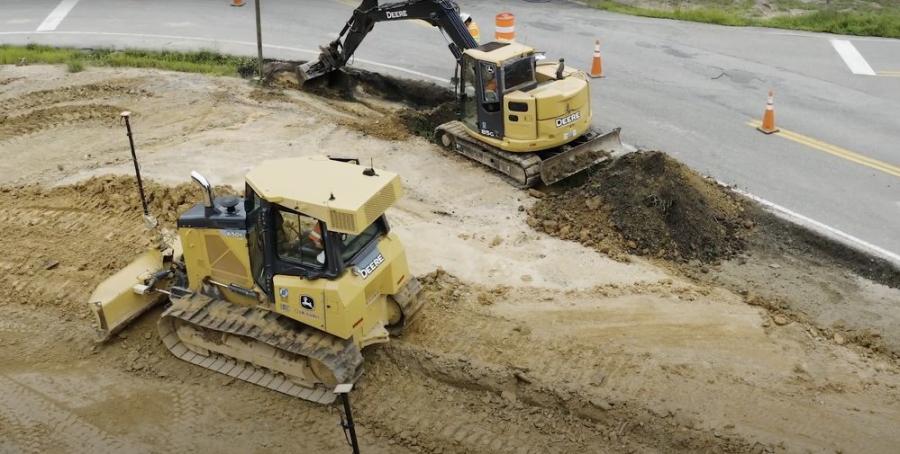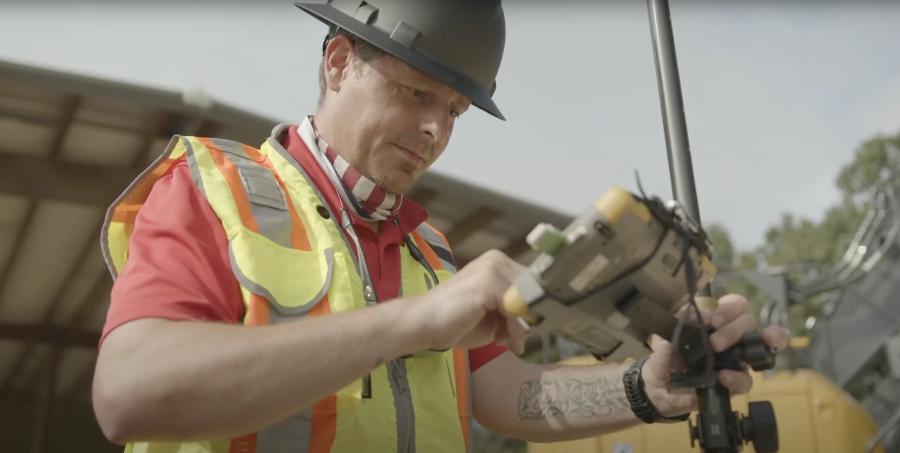
Thu January 21, 2021
Giles Lambertson – CEG Correspondent
Automated. Robotic. Precise. These and other adjectives characterize construction equipment today. The question that sometimes follows is, to what end? As it turns out, that's a pretty good question. James River Equipment offers some answers.
The John Deere dealership with a string of stores across Virginia and North Carolina is committed to promoting the use of ever-more technologically sophisticated machinery and in utilizing the technology in its operations. "We are working very hard to become cutting edge on technology," said company President Mark Romer.
Deere itself is heavily into technological solutions for contractors. That became apparent to Alex Dixon when the manufacturer began to roll out its SmartGrade crawler dozers (2016) and motor graders (2019) with integrated machine controls.
"That was when it became clear to us that the expectations of us as a dealer were shifting," said Dixon, the company's manager of Worksight Solutions. "It made us shift our focus on technology. We could see clearly that GPS machine control was not going to be a niche part of the market any longer."
**
Technologies that today are having so much impact on construction equipment — and machinery in allied industries such as agriculture, landscaping and forestry — are not really new. Rather, they are new-generation systems rooted in scientific and engineering explorations of the 20th century. Computer software dates to the 1940s, lasers to the 1950s, electronic miniaturization to the 1960s, the satellite-based Global Positioning System to the 1970s.
These and other technologies began to come together on construction job sites in the 1990s and early 2000s. Names like Topcon, Trimble and Leica now are as familiar to many construction contractors as are the names of leading heavy equipment manufacturers. Increasingly, the brands are mentioned in the same breath.
James River Equipment is considered tech-savvy. Dixon noted that in the same way technological advances are embraced in other aspects of our lives — i.e., smartphones — "tech is the future in construction. We've expended a lot of effort being innovative and staying on the cutting edge. Our Worksight Solutions team is an embodiment of that. The team concentrates on two areas: machine control and consulting with customers on fleet management, maintenance and support."

The grade control specialists "champion the technology" by showing customers how to use the controls installed at the factory, or the devices added later. The specialists have authoritative knowledge of construction machinery or are deeply experienced engineers and satellite positioning experts. They bring their expertise to bear in helping equipment owners fully utilize machine control technology.
The Worksight team's second purpose — fleet management and support — is achieved through telematic connections. "We observe about 12,000 machines and respond to about 200 alerts a day," Dixon said. Monitoring stations are sprinkled across the dealer's network of stores, but employees dedicated to monitoring do so from big screen centers in Ashland and Manassas in Virginia, and Charlotte and Raleigh in North Carolina.
When a machine appears to be under-functioning or malfunctioning, they are on the phone to the equipment operator or owner, a much more rapid intervention than otherwise would be possible. A James River Equipment technology team equivalent to Dixon's works the ag equipment side. There is plenty to track there, too, with Deere currently pushing development of an autonomous electric tractor, an autonomous drone sprayer and various artificial intelligence advancements.
Because GPS is central to machine control, much of the company's tech support on the construction side begins there. Fine-tuned positioning of dozer blades and of excavator buckets, for example, is dependent on the satellite feeds. On the ag side, the global positioning component is less about interfacing with a machine and more about harvest calculations and mapping and such.
"John Deere is very focused on technology," Dixon said. "There's no doubt about it. It's in every product line. We at James River Equipment really do have the same focus. We're aligned with Deere. We want to push ahead in innovative ways and produce specific results for our customers."
**
The performance of today's equipment keeps growing, if incrementally in some areas. Dixon attributed the growth to the development of ever-more responsive equipment as well as to proliferation of GPS constellations and capabilities. In addition, after-market devices are complementing integrated solutions. Example: GPS controls are teaming up with robotic Total Stations for even greater accuracy.
So, the question: How much technology is enough? Is building a grade within a quarter of an inch of a planned level really more valuable than coming within, say, an inch and a half? Yes, according to Dixon. "It is not just about the result, but how you get there. The performance technologies not only give a precise result, they produce productivity and efficiency. The intersection of quality work, productivity and efficiency is where you generate the profits you're after."
The Worksight Solutions manager acknowledged continued resistance to the technology revolution. One reason: A leap forward in performance usually means a leap upward in cost. "If we could promote the fact that investing in the equipment will produce X amount more efficiency, we would, but customer situations are so variable. There is no one formula for return on investment because workload is so different. But customers who do invest tell us they see the results. The math is working for them."
He differentiates between the price tag of a new technology and cost. "There still are a lot of folks out there who don't use new generations of technology. No problem. We partner up with those customers the same way we have in the past. But we do promote making the investment and improving performance of their equipment and their business. The true cost of technology should be calculated at the very end, in the results produced by it, not in its price tag. People who invest in technology and know how to use it and how to operate it, they achieve extraordinary results."
He added that a step-by-step approach works for some. That's why Deere equipment can be fitted for a basic 2D control system and later upgraded to accept a 3D automatic system. A customer can be shown how to start out with a basic piece of equipment and then move up to a more comprehensive solution.
**
The process of utilizing technology is enhanced through James River's customer training. Dixon said the company's mobile classroom is an effective teaching module. "We can take classes to a customer at his convenience, teach a couple of operators at a time or a whole crew. It lets us talk about a machine in the classroom and then step right outside the door and hands-on demonstrate the technology. But there are times when a conference room here at the office or a training room in a dealership is the better setting for a class."
Customers haven't asked for virtual training sessions, but videos, slide shows and interactive media are common. Then there are the simulators. "We have one trailer set up with machine simulators," the manager said. "It's a pretty hi-tech set-up, sort of Bulldozer Meets Video Game. It's entertaining because it's cool, but it is very realistic."
The simulated training is used with new-hire and experienced operators alike. It also is rolled out for open house demonstrations and training events at dealerships where they can't actually get on a machine and push dirt.
Typical training sessions are, well, not typical because the sessions are held for a host of reasons. Training supports the delivery of a new piece of equipment. Or it can help a company familiarize a veteran crew with a new grade control feature. Brand new operators are introduced to a machine in some sessions. The training can be for a customer's tech specialist who, in turn, trains operators. Shop techs are trained on maintenance and repair.
How about CEOs? Do the people at the top ever come to the classes? "Sometimes," Dixon said. "CEOs or owners who are engaged with what is going on in the operations side of their companies do show up for the training sessions."
With new models and technological features continuing to roll out of executive suites in Moline, Ill., the need for training isn't going away. Dixon cited updated technology in Deere's L Series crawler dozers. Some excavators are being upgraded from GPS indicate-only to automatic operation. This year, Deere is introducing its mastless 333G SmartGrade compact track loader, the first one with integrated controls.
To keep customers current on innovations, the company has eight specialists spread out across Virginia and North Carolina dedicated to the task of keeping operators up to speed.
"This business is about people more than anything," Dixon said. "Equipment is what we do, but people is who we serve, both employees and customers. If we continue to put that people value ahead of all the other stuff, we'll all be successful." CEG
This story also appears on Construction Equipment Guide.
 Aggregate Equipment
Aggregate Equipment Articles
Articles Sign up for Updates
Sign up for Updates Sell Your Machines
Sell Your Machines

 Aggregate Equipment
Aggregate Equipment Aggregate Dealers
Aggregate Dealers Aggregate Articles
Aggregate Articles Sign up for Updates
Sign up for Updates Sell Your Machines
Sell Your Machines